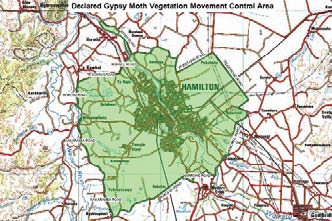PESTS AND DISEASES OF FORESTRY IN NEW ZEALAND
Waikato residents support moth trapping programme
from Biosecurity 49, February 2004.
Intensive eradication and monitoring operations against the Asian gypsy moth (AGM) have continued in and around Hamilton over the summer. To date, no further moths have been discovered.
During October and November 2003, eight early morning aerial treatments using Foray 48B were successfully completed over a predetermined area of Hamilton. Aerial treatment was targeted at eradicating any AGM caterpillars.

The focus of the response now moves to detecting male moths using traps, and maintenance of a controlled area to restrict movement of vegetation.
Over the last few weeks almost 1,700 traps have been placed out to 30 km from where the AGM was first trapped. Traps have been placed on favoured host trees such as oak and willow at a height of 1.5 – 2 metres, the ideal height for capturing any male moths. Traps are being checked throughout summer.
Using a ‘mass trapping’ strategy, traps have been placed at 25-50 metre spacing within a 1km radius to act as both a detection and confusion technique.
Nearby towns monitored
Outside the 1 kilometre zone, traps are spaced from 250 metres up to 1 kilometre, depending on distance from the original find, and are targeted at detection of any male moths. A large number of traps have also been placed at six nearby towns: Cambridge, Matamata, Morrinsville, Ngaruawahia, Horotiu and Te Awamutu.
The aerial treatment targets the AGM’s caterpillar stage. The detection and mass trapping phase goes after the adult male. AGM traps are baited with a female sex pheromone to attract male moths. Pheromones are chemicals emitted by living organisms to send messages to other organisms of the same species. They are emitted particularly by the female of the species to attract a male at mating time.
Each trap has been baited with the specific gypsy moth pheromone, disparlure. The interior of the trap also contains a non-toxic sticky substance; the moth flies in, gets stuck, and remains in the trap until checked.
Trapping alone will not get rid of every moth but it will give MAF good information about any residual population on which to base any further action.
Positive response to trapping programme
MAF has been overwhelmed by the positive response and cooperation of Waikato residents when trappers have sought permission to set traps on their properties. Many residents have taken a personal interest in the AGM programme and are regularly ringing the AGM hotline (0800 969696) with reports of unusual moths and other bugs in the neighbourhood. MAF responds to all public enquires.
To complement the trapping programme MAF has invoked, under the Biosecurity Act, a Controlled Area. This involves controlling the movement of any vegetation outside an area of around 7 km from the trapped moth. AGM life stages (e.g. eggs, caterpillars) are easily transportable and the insect could ‘hitch hike’ out of Hamilton. The purpose of the controlled area is to minimise the chances any such movement.
MAF is remaining focused on eradicating this high impact defoliator from Hamilton. Given that it will take two years of negative trapping and no finds to declare the AGM officially eradicated, there is still a lot more work to do.
For information on the AGM response:
www.maf.govt.nz/gypsy-moth
Mark Ross,
National Adviser
Pest Surveillance and Response,
Forest Biosecurity

 Farm Forestry New Zealand
Farm Forestry New Zealand

